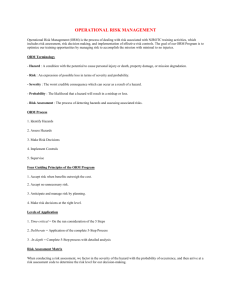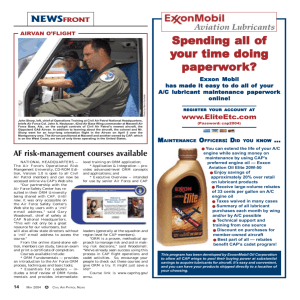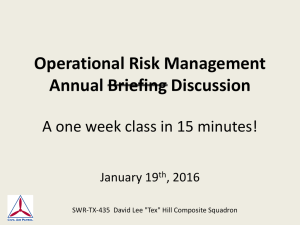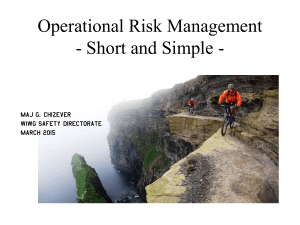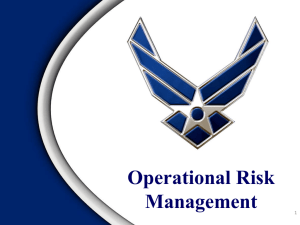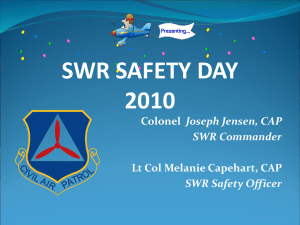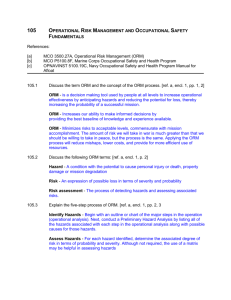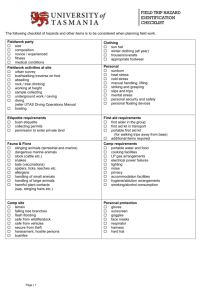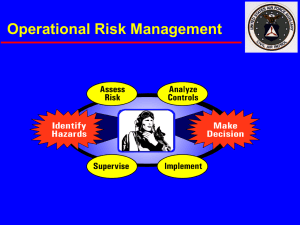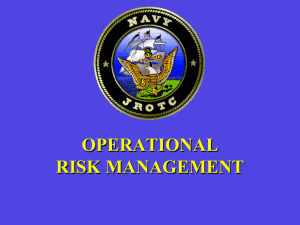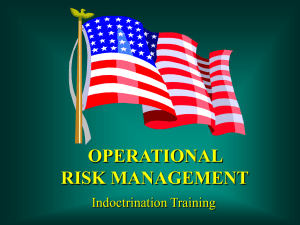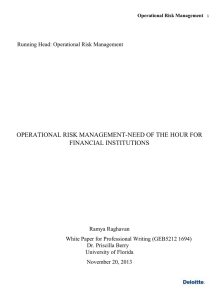Operational Risk Management Annual Briefing
advertisement
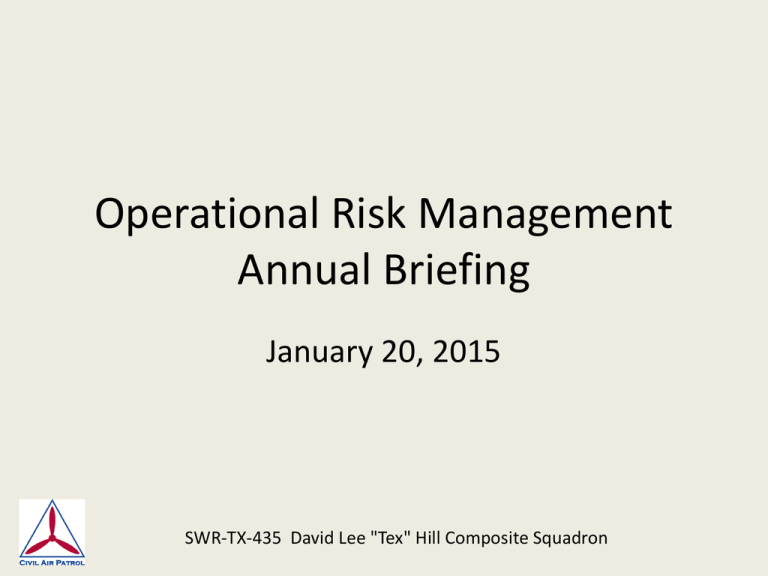
Operational Risk Management Annual Briefing January 20, 2015 SWR-TX-435 David Lee "Tex" Hill Composite Squadron CAPR 62-1 CIVIL AIR PATROL SAFETY RESPONSIBILITIES AND PROCEDURES 3d(1): At least once annually, Operational Risk Management (ORM) will be discussed during a unit safety meeting. If anyone asks if you have received your annual ORM briefing…the correct answer is “yes, I have”. What the heck is ORM? a methodical, six-step process to “manage” risk “manage” means diminish, limit, or eliminate Why should I care about it? 1. It’s required (while “on duty” at CAP) 2. It’s a good idea (when not “on duty”) 3. It reduces mishaps mishaps = personal injury and damaged property Operational Risk Management NOT exclusive to the Civil Air Patrol Most Federal Agencies All DOD Agencies (USAF, USMC, etc.) Most Industrial Businesses Fortune 500 Companies It costs money to implement ORM If it didn’t work, they wouldn’t do it SWR-TX-435 David Lee "Tex" Hill Composite Squadron It’s required for CAP Pilots, Ground Teams, and activities BUT You can use the same principles anywhere! …you just don’t have any forms to complete Without “operational” it’s still “Risk Management” which, is a GOOD idea. On Duty … it’s a formal process with forms to fill out and people to notify Everywhere Else … it’s pretty much just deliberate thinking and applying common sense We will review the formal process first. Then we’ll talk about the informal process. So…..you said that it’s a six step process? 1. Identify the hazards 2. Assess the risks 3. Analyze the risk control measures 4. Make control decisions 5. Risk control implementation 6. Supervise and review Don’t bother memorizing these steps….just follow the checklist. ORM Checklist for Ground Team Note similar “hazards” on Flying Checklist: Fatigue Weather Experience Here are the six steps Note…… the higher the risk level the higher the approval authority ORM Checklist for Flying Note that there are “No Go” hazards Poor Health or Fatigue Broken Airplane Bad Weather Again note, that the higher the risk level the higher the approval authority Everyone else’s ORM checklist Risk Management Worksheet…Page 2 1. Identify Hazard: those things most likely to have a negative impact on the mission 2. Assess Risk: use the Risk Assessment Matrix 3. Develop Controls: for each hazard to reduce its risk Specify who, what, where, when, and how for each control 4. Determine Mission Risk: From Block 6, identify hazard with highest residual risk Circle the appropriate risk level in Block 8 5. Make Risk Decision: Unit commander will determine authority and level for risk acceptance 6. Implement Controls: Decide how each control will be put into effect Enter in Block 10 7. Supervise: Show how each control will be monitored to ensure proper implementation …Enter in Block 11. 8. Evaluate: After mission is complete, determine effectiveness of each control in reducing the risk of the targeted hazard. 1. Identify the hazards 2. Assess the risks 3. Analyze the risk control measures 4. Make control decisions 5. Risk control implementation 6. Supervise and review Any questions so far? ORM … not just with CAP … but everywhere else too Remember from the formal checklist instructions Hazard: those things most likely to have a negative impact on the mission So what is your “mission” when you aren’t at CAP? Your daily mission (as a minimum) 1. Return home without injury 2. Return home without having damaged any property It’s impossible to make a “checklist” for every hazard in life So…what should get my attention? Jim’s Biggies…extra thinking required! Warning Labels Gasoline Also…from our CAP checklists: Fatigue Bad weather Lack of experience When you are “OFF” the ground 1. Remember: An ounce of prevention is worth a pound of cure! 2. Don’t ruin your life with “analysis paralysis”. If you are engaged in normal everyday stuff…press on and have fun. 3. However, if it is dumb, dangerous, or different: bad weather (rain is considered bad weather) a new activity that you are not intimately familiar with you are tired or aren’t feeling well you see “warning labels” attached gasoline is involved (chainsaws, dirt bikes, wave runners) ladders or scaffolding are involved 4. Think on it a bit before you begin. Your “take home” message U.S. Department of Defense four principles of ORM 1. Accept risk when benefits outweigh the cost 2. Accept no unnecessary risk 3. Anticipate and manage risk by planning 4. Make risk decisions at the right level In Summary 1. At CAP Activities … use the formal checklists (it’s required) 2. Everywhere else…think and use common sense (it’s smart) A. YOU are the final “approving authority” B. YOU can always simply choose to say “NO” If you can’t reduce the risk….consider calling it a day Questions? Next Month: “Safety Day” Probability Frequent Likely Catastrophic S E V Critical E R Moderate I T Negligible y Occasional Seldom Extremely High High Medium Low Unlikely Frequent: Occurs often, happens many times during a single activity Likely: Occurs regularly, generally happens once per activity Occasional: Occurs infrequently, doesn't occur at every event, but occurs often enough to be considered Seldom: Occurs sporadically, only happens once or twice in an entire CAP career Unlikely: Occurs rarely, often never occurs during an entire CAP career Catastrophic: Complete mission failure, death, or loss of system Critical: Major mission degradation, severe injury, occupational illness, or major system damage Moderate: Minor mission degradation, injury, minor occupational illness, or minor system damage Negligible: Less than minor mission degradation, minor injury, occupational illness, or minor system damage
